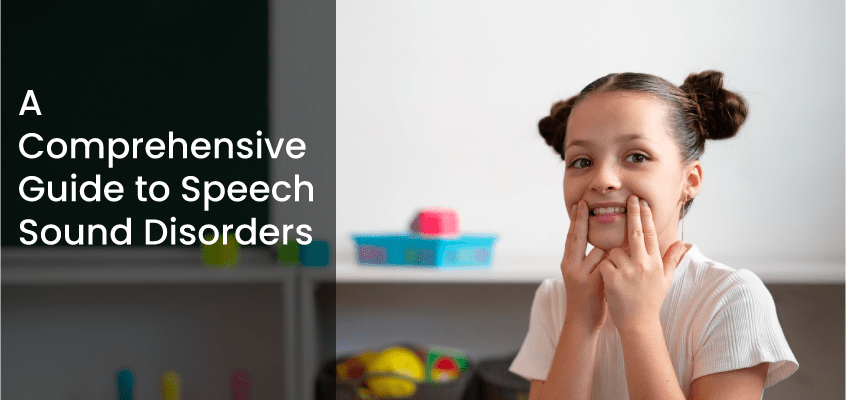Introduction
Speech sound disorders (S.S.D.) are a type of communication disorder that can affect a person’s ability to produce and correctly pronounce certain sounds. You may wonder what this means if one has this disorder. This guide will help you understand the different types of S.S.D.s, their causes, and available treatments.
What are speech sound disorders?
Speech sound disorders are developmental disorders in which a child’s speech patterns do not coordinate with the gestures and movements of their body while speaking. Speech impairment is prevalent during childhood and tends to interfere with academic performance.
Speech sound disorders indicate a child’s difficulty learning and articulating thoughts using sounds and language. They will also find it difficult to communicate using body language and gestures. Therefore, speech sound disorders presumably impact the cognitive skills of the affected children.
Children suffering from S.S.D. often face challenges in expressing their thoughts publicly. They display difficulty in coordinating or moving the required muscles necessary for speech. It results in compromised communication abilities. Hence, children with S.S.D. may not have fully-developed cognitive functions and related skills. It also influences their regular activities and lifestyle.
Types of speech sound disorders
We know that by the time a child is about three years old, they should be able to understand and respond while engaged in conversations. Similarly, all words and sounds must be well-pronounced correctly by age four or five. However, there may arise exceptions when pronouncing certain letters like “l,” “s,” “r,” or “v.” A child suffering from a speech sound disorder will continue to struggle to pronounce such words even past the expected age. The following are different types of speech sound disorders:
- Disfluency: This condition involves recurrent interruptions while speaking. Stuttering is a common form of dysfluency. It affects the free flow of speech and causes recurrent breaks between lessons. This disorder may cause speaking tension, characterized by head jerking or blinking. Children suffering from this disorder often feel frustrated or embarrassed while speaking.
- Articulation disorder is usually noticeable when the child changes the pronunciation of different alphabet letters. It is probably due to incorrect placement of pressure or stimulation on the lips or throat to produce sounds. Only parents and close family members can understand the child’s communication in such cases.
- Phonological disorder: This is a condition where a child is unable to produce sounds or speech as expected according to their age. They make mistakes while producing sounds or words.
- Voice disorder: An early sign of this disorder is a raspy voice. In a voice disorder, the child’s voice usually breaks, changes pitch or becomes extensively loud or soft while speaking. Children with this disorder tend to run out of breath while speaking.
- Apraxia: When a child lacks the proper skills required for sound production, it indicates apraxia.
Symptoms of speech sound disorders
The symptoms of speech sound disorders may manifest in different ways. They predominantly depend upon the severity of the disorder and the associated underlying factors. If your child has trouble making certain sounds or frequently mispronounces words, they may have a speech sound disorder. Some common symptoms of speech sound disorders include:
- Unintelligible speech containing phoneme addition, omission, distortion, or substitution interferes with verbal communication.
- Interference with social participation, academic performance, or occupational performance (or any combination thereof)
- The onset of symptoms is during childhood.
- Symptoms are not due to another medical or neurological condition, including T.B.I. (Traumatic Brain Injury).
If you’re concerned that your child may have a speech sound disorder, the first step is to talk to your paediatrician, who can refer you to a speech-language pathologist for an evaluation. With early intervention and treatment, most children with speech sound disorders can learn to speak clearly.
Causes of speech sound disorders
There are many potential causes of speech sound disorders. Some common causes include:
Biological factors:
- Gender: A male child is likelier to have speech sound disorder than a female.
- Hearing loss: One of the most common causes of speech sound disorders is hearing loss. Not being able to hear can make it difficult for a child to learn how to produce certain sounds correctly.
- Premature birth: Premature birth can sometimes lead to speech sound disorders because it can interfere with a child’s normal development.
Environmental factors:
- Injury to the brain or nervous system: Any brain or nervous system damage can potentially cause a speech sound disorder.
Psychological factors:
- Certain medical conditions: Several medical conditions can lead to speech sound disorders, such as cerebral palsy, Down’s syndrome, and autism spectrum disorders.
Treatment of speech sound disorders
If your child has a speech sound disorder, there are many different types of treatment options available. The best approach will likely involve a combination of therapies, which may include:
- Articulation therapy focuses on improving how your child produces specific sounds. The therapist will work with your child on correcting the target sounds in isolation, syllables, and words.
- Phonemic awareness therapy helps your child become aware of the individual sounds (phonemes) in words. The therapist will work on activities to help your child identify and manipulate phonemes.
- Language intervention activities help improve your child’s understanding and use of language. During the session, the therapist may use vocabulary development, sentence construction, and story-retelling activities.
- Oral motor exercises help strengthen the muscles used for speech production. The therapist may have your child blow bubbles, chew gum, or make funny faces to exercise the powers used for speech.
The best way to determine which treatment approach is best for your child is to consult a speech-language pathologist.
Conclusion
Speech sound disorders are developmental disorders that predominantly affect children and their ability to speak, articulate and learn. The symptoms and treatment strategies depend upon the severity of the condition. Although there are no known causes of speech sound disorders, there may be particular risk factors such as genetic predisposition, underlying diseases, environmental factors, and prenatal or postnatal complications.
If your child is showing symptoms of a speech sound disorder, worry not! We at United We Care can connect you with the best child psychologists to help your child achieve his ultimate potential. Speak to an expert today!
References
- Plumptre, E. (18 March 2022). How are children affected by a speech sound disorder? Verywell Mind. Retrieved 23 August 2022, from https://www.verywellmind.com/speech-sound-disorder-types-causes-treatment-5220400
- American Speech-Language-Hearing Association. (n.d.). Speech sound disorders. American Speech-Language-Hearing Association. Retrieved 23 August 2022, from https://www.asha.org/public/speech/disorders/speech-sound-disorders/
https://www.asha.org/practice-portal/clinical-topics/articulation-and-phonology/









